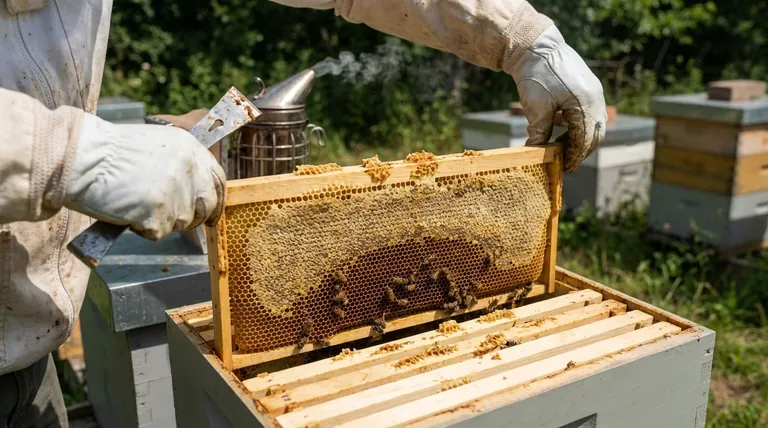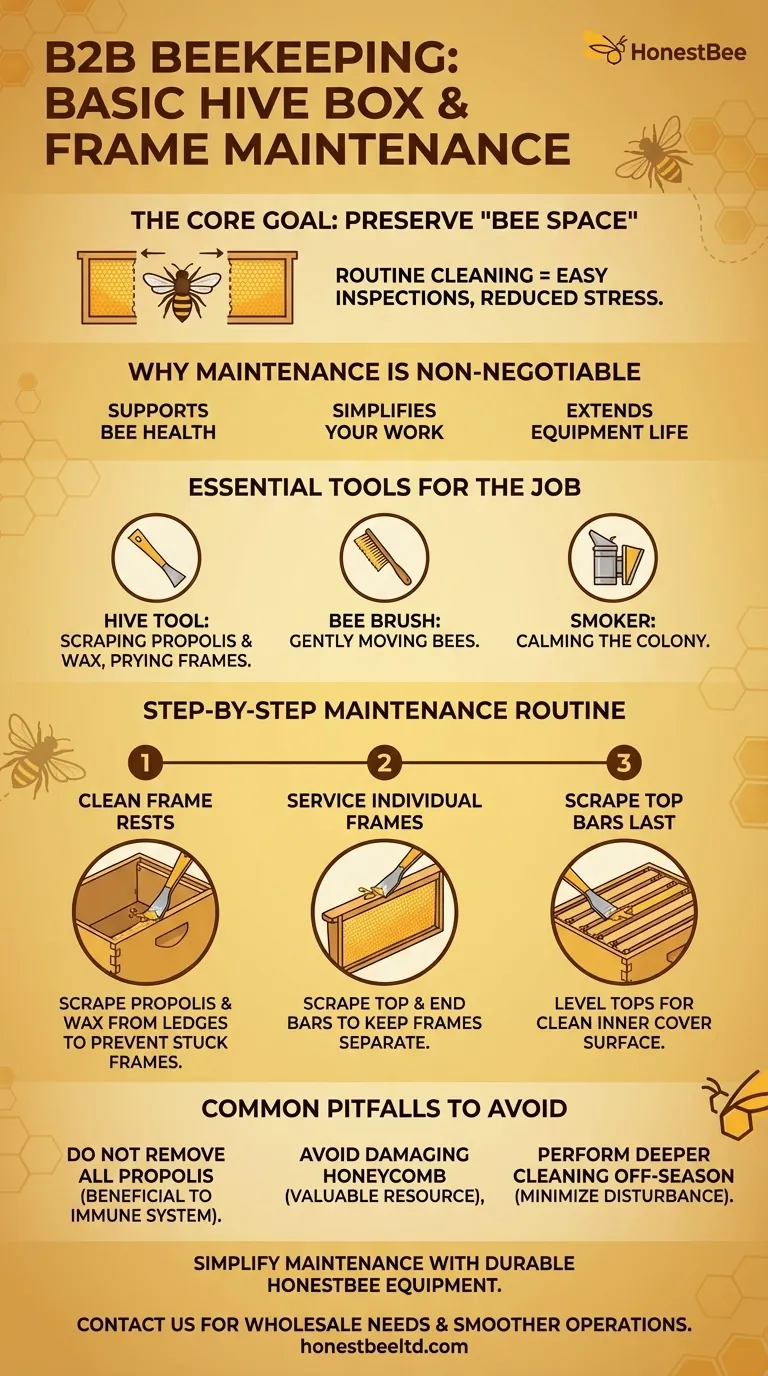The most basic maintenance for hive boxes and frames involves a simple, routine cleaning process. During each inspection, you should scrape excess propolis and wax from the frame rests inside the hive box and from the top and end bars of the frames themselves. This single act prevents parts from getting glued together and makes future inspections significantly easier.
The core goal of hive maintenance is not just cleanliness, but preserving the hive's critical "bee space." By routinely managing propolis and wax buildup, you ensure frames remain easy to remove, which reduces stress on both you and your bees during inspections.

Why Routine Maintenance is Non-Negotiable
Effective hive maintenance is a proactive measure that supports bee health, simplifies your work, and extends the life of your equipment. It revolves around managing what the bees naturally build.
Understanding Propolis Buildup
Bees use a resinous substance called propolis to seal cracks, reinforce comb, and protect the hive from pathogens. It acts as the colony's glue and immune system.
However, bees will use propolis to fill any gap that is not precise "bee space." This means they will glue frames to the box and to each other, making them difficult or impossible to remove without jarring the colony.
Preserving Bee Space and Hive Integrity
Proper spacing is essential for a healthy hive. Maintenance ensures frames are positioned correctly, which allows for proper airflow and efficient comb building.
Scraping the frame rests (the ledge the frames hang on) and the meeting surfaces of the frame end bars prevents this critical spacing from being compromised by propolis buildup.
Preventing Pest and Disease Havens
Cracks in the wooden boxes or broken frames can become hiding places for pests like wax moths and small hive beetles. Regular inspection and repair of your equipment eliminate these potential sanctuaries.
The Essential Tools for the Job
You do not need a large toolkit for basic maintenance. A few key items are all that's required to perform these tasks efficiently during a standard hive check.
The Hive Tool
This is your primary maintenance instrument. The flat end is used for scraping propolis and wax from flat surfaces like frame tops and box edges, while the curved end is perfect for prying apart frames that have been sealed by the bees.
The Bee Brush
A bee brush is used to gently move bees off a frame before you begin scraping. This prevents you from accidentally rolling or injuring them while you work.
The Smoker
A smoker helps calm the bees, making the entire inspection and maintenance process less stressful for the colony. A few gentle puffs of smoke mask the alarm pheromone, encouraging the bees to be more docile.
A Step-by-Step Maintenance Routine
Integrate these steps into your regular hive inspections. The best time to perform this work is when you already have the hive open.
1. Clean the Frame Rests
After removing the first one or two frames to give yourself room to work, use your hive tool to scrape all the propolis and wax buildup off the frame rests on both sides of the hive box. This is the most important step for ensuring frames don't get stuck.
2. Service the Individual Frames
As you inspect each frame, take a moment to clean it. Use your hive tool to scrape excess propolis from the top bar and the end bars where they make contact with other frames. This keeps them from being glued together in a single mass.
3. Scrape the Top Bars Last
Once all frames are back in the hive and properly spaced, run your hive tool across the tops of all the frames at once. This creates a clean, level surface before you place the inner cover back on.
Common Pitfalls to Avoid
While maintenance is crucial, it's possible to be overzealous. The goal is management, not sterilization.
Don't Remove All Propolis
Remember that propolis is beneficial for the bees' immune system. Scrape it from contact points and frame rests where it causes mechanical problems, but don't try to remove every last trace from the interior walls of the hive.
Avoid Damaging Comb
Be careful when scraping frames. Drawn-out honeycomb is an incredibly valuable resource that takes the bees a massive amount of energy to create. Work carefully to avoid gouging or breaking the wax comb.
Perform Deeper Cleaning Off-Season
More intensive maintenance, like scorching boxes to sterilize them or making significant woodenware repairs, should be done after the honey harvest or before the season begins. This is best performed on empty equipment to minimize disturbance to the colony.
Integrating Maintenance into Your Beekeeping
Your approach to maintenance should align with your primary goals as a beekeeper.
- If your primary focus is efficient inspections: Always prioritize scraping frame rests and the contact points on frame end bars every time you open the hive.
- If your primary focus is long-term equipment health: Conduct a thorough inspection, cleaning, and repair session on all your boxes and frames after the final honey harvest.
- If your primary focus is colony health: Be vigilant about repairing any cracks or holes in hive bodies that could allow pests in or create drafts.
Consistent, minor maintenance is the key to a smoother, more enjoyable, and more successful beekeeping experience.
Summary Table:
| Maintenance Step | Key Action | Primary Benefit |
|---|---|---|
| Clean Frame Rests | Scrape propolis/wax from ledges inside hive box. | Prevents frames from getting stuck. |
| Service Frames | Scrape top and end bars of each frame. | Keeps frames from being glued together. |
| Scrape Top Bars | Level the tops of all frames after inspection. | Ensures a clean surface for the inner cover. |
Simplify your hive maintenance with durable, precision-engineered equipment from HONESTBEE.
Routine upkeep is essential, but it's far easier with high-quality supplies designed for commercial apiaries and distributors. Our wholesale-focused operations provide the robust hive boxes, frames, and essential tools you need to perform maintenance efficiently, reduce colony stress, and protect your investment season after season.
Contact HONESTBEE today to discuss your wholesale needs and discover how our equipment supports healthier colonies and smoother operations.
Visual Guide

Related Products
- Langstroth Bee Hives Bee Keeping Box for Beginners Beekeeping
- Australian Langstroth Beehive Boxes for Beekeeping Wholesales
- HONESTBEE Professional Long Handled Hive Tool with Precision Cutting Blade
- HONESTBEE Advanced Ergonomic Stainless Steel Hive Tool for Beekeeping
- Langstroth Honey Bee Box Hive Boxes for Different Depths
People Also Ask
- Why might a beginner be advised to start with a Langstroth hive? Unlock a Supportive Beekeeping Ecosystem
- What are the key features of the Langstroth beehive? A Guide to the Standard for Modern Beekeeping
- Why were wooden hives traditionally preferred? For Natural Beekeeping Aligned with Bee Biology
- Why are Langstroth hives recommended for beginners? Unmatched Support & Standardization
- What basic equipment is needed to start beekeeping? Your Essential Guide to a Confident Start



















